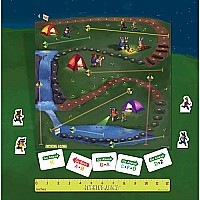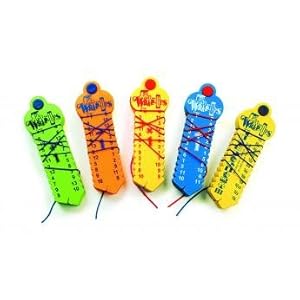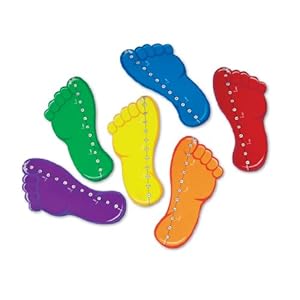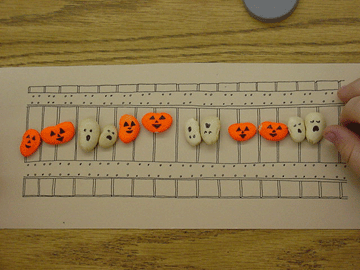I have a classroom of gifted kids. I have from age 6 to age 8 in my class. I have students who can do division and know mostly all of their multiplication facts, and I have some kids who still don’t know their addition facts.
| We do a Weekly Graph in a pocket chart on a variety of topics. Then they all sit down and take a turn telling me something about the graph using “math words”. |
So I have to group kids in math like I group them in reading. IT IS NOT EASY! Let me repeat, doing any kind of differentiation is NOT EASY. I rarely have time to come up with individual lessons for my high kids because I’m helping my low kids get the basic lesson. But I can do it once a week. Any teacher can with some preparation time on Friday afternoon.
CHECK OUT PINTEREST FOR THE PAGE ON MATH GAMES. THE LINK IS HERE! Many of them can be purchased cheaply or made at home.
Here are a few things that help me differentiate in Math
1. Having Flexible Math Groupings
2. Having multiple and changing learning stations and centers for math
3. Doing timed tests in math facts as far as the kids can go at their own level.
4. I do every page of the student workbook and finish it by year’s end. I don’t skip concepts.
5. We do a writing project in math probably 6 times a year.
6. I have many purchased games and math manipulatives to use with games to make math more fun!
HERE at Printable Math Worksheets are charts and worksheets for learning math facts. This also needs to be a part of any good math program. The kids need timed tests to master and drill their facts into memory. We could spend 5 minutes three times a week taking and correcting timed tests and have the whole class mastering math facts all year.
CENTERS OR LEARNING STATIONS IN MATH
Learning Centers are up every day, all day, and they are really the favorites of my students. I have 2 centers out at each table all day; one center is a language arts station, and the other is a math station. The kids are told in the mornings, when they are done with their writing work, that they go to the L.A. center, and in the afternoons, when they are done with their independent work, they can choose a math center.
 |
| A fun game to teach inches and measuring. |
| I copied this free printable to go on the upper inside flap of each page from Enchanted Learning. |
I have 5 centers of each at 5 areas
1. The rug. Math puzzles, matching games, flip overs, etc.
2. The round game table. (a small shelf next to it has board games, Bingo games, file folder games)
3. The long, mom-helper table (RUBBER STAMPS) It has rubber stamp clocks, money, base 10 etc. so kids can make their own problems up and answer their own rubber stamped problems.
4. The filing cabinets (MAGNET CENTER) I’ve made lots of games magnetic and I also have magnetic ABCs and Numbers so it is always a popular one.
5. Listening Post/Weekly Graph. I always have a math book on tape as well as a weekly graphing assignment to do. The kids get their graphing done by Friday.
 |
| These are good games for a math center. They are played independently and kids love the MATCH UPS! |
Some are just purchased games such as SUM SWAMP. IT IS ALWAYS A FAVORITE math game. It includes addition, subtraction, multiplication and division. The kids choose which operation to play.
 |
| This game is in my STORE in the BUTTON ABOVE. Please go take a look! |
Most of the kids loved my math games and centers, and it would be a motivation to get their work done so they could go play a math game afterwards. Morning fast finishers do the Language Arts activity at one of the 5 centers.. Afternoons they would do the math activity at the same center. I don’t change centers very often, maybe every 2 weeks or so. I am lazy. And with 5 centers, most kids would only go twice to each center in a 2 week period. 😀
| The MATH CENTER in the background is a math game in a pocket chart. It is like Jeopardy in that it has catergories of math and amounts for difficulty of question. Kids play it with a few partners. |
DIFFERENTIATING FOR THE HIGHER LEVEL KIDS
I find that on Mondays, I don’t have any specials (P.E. Library or Computer), so I have an extra half hour of the day that isn’t really integrated with anything else. And I’m usually starting on a new topic in Social Studies, Science and sometimes Math. So it’s a good time to start something new. So that was the day I decided to plan and prepare for a special lesson in math for those high kids in my class. We named them “THE MATHEMATICALS”. They LOVE being called that.
I call them over as soon as I’m done with my math lesson for the day, knowing they will complete the independent work quickly and can be ready for something much more challenging. I found stuff in the next grade up and further that was simple to teach, yet would be new information; such as multiplying double digits, or simple division, quadruple addition or subtraction, brain teasers etc.
| I have a bingo game on almost every topic I teach. I think it is a good use of money. The kids love them, they teach each other how to run the games, and they learn as they play at centers. Some years I have had to assign a “game caller” to run the game. It would be a high student who could help others play the game. Kids love to be in charge!! |
The Mathematicals group would meet with me on Monday after the regular math lesson. They each have a folder and I will give them a page with higher level work on it with the same theme or math strand if possible. If not they got a brain teaser or word problems or simple multiplication. You’d be surprised how many kids can do it even in first grade. I got the worksheets online or from the above grade level old series of math…. so I wasn’t copying anything current that they would do the next year. They would usually finish the worksheet by the end of the week doing a little bit each day on their own. Then they still had time to go to centers.
 |
| Here are my “foam feet” I use to teach inches, feet and yards. Check out ordering a set from my estore in the button above. |
The week we were doing measurement for differentiation I had them do a “yardstick” by tracing my 1 foot “foam feet” in sets of 3, making the inch increments and totalling the 36 inches. You can see the final product hanging from the ceiling. They then had to measure 3 things in the room in feet using tools such as rulers and measuring tape. They loved it! And some of the other fast finishers did it too.
They had to list inches, centimeters, and feet for totals measured. It was fun and challenging for my first graders that year. And everybody learned the vocabulary for inches, feet and yards.this way, by actually doing a silly art project!!! They would also have done some paper and pencil measurement pages that were higher level that week.
Sometimes it would be a page on 2 step word problems with triple digits or quantities of money or 2 step operations in telling elapsed time. Other times it would be writing out in words numbers in the 100 thousands. Stuff like that. It wasn’t too far developmentally that they couldn’t do it, and they thought it was fun.
| Here a group doing differentiated math using “foam feet”….it would be some project above and beyond the regular assignment for the day. |
REMEDIATING AND RETEACHING
FOR MY LOWER KIDS
My low kids would get me every day at the kidney shaped table, after the whole group lesson is done and nobody else has questions. At this time all are working on their independent work. The high group, The mathematicals, would have had their weekly meeting with me already.
I meet almost daily with the low group to help them understand and do the regular daily work. I send them back to their desk individually when they had more than half the work done. The other kids in the class are finishing at their own pace and then going to one of the 5 centers.
| I have a few store bought games on each math strand. Some I have made up myself, some I use games I have made in file folders and put inside a baggie. |
The faces would change at the kidney table (low math group), depending on the strand of math. Some kids would volunteer to come back to me. Some I would call back because of what errors I’d seen on yesterday’s corrected work. That always told me who didn’t “get it” yet.
Some were low in money counting. Some were low in understanding word problems, some were low in fractions, etc. The math hour would be complete when everybody got that day’s work done and had a little time for center games/workstations.
 |
| Extra activity we do every day for 10 minutes…ADD MATH…..I like the “word problem” a day and the math facts practice. |
| My measurement unit has a lot of hands on activities. The kids really learn the different vocabulary by using the tools of measurement. (inches, feet, yards, yardstick, meter stick, centimeters, etc.) |
I HATE to hear teachers say, “well we don’t have to teach that, because it’s not in our core!” It just makes me cringe!!!
Why not do some higher level stuff? Or stuff in the math book that is not required at your grade? What does it hurt? You will be addressing those high kids in your class that WANT and NEED more challenge!! That is a way to differentiate. Let those who are easily bored do a different project once in awhile, even if you only challenge yourself to do a differentiation project once a month, you are helping high level kids learn something they are ready for.
It’s kinda my mantra. My kids were often bored in elementary school. And everybody has kids in their class like that. So address it. Give it some of your planning time. If you only make up one extra activity a month this year and add another one next year (per month) you will soon have something once a week for the entire year for high level kids.
And then won’t you be proud of yourself.
Yes, you will! I PROMISE!

